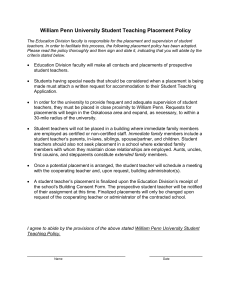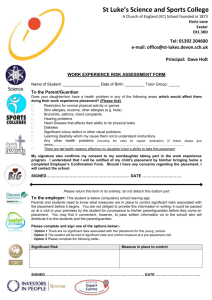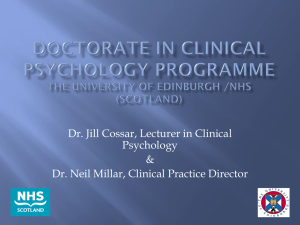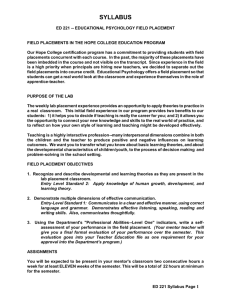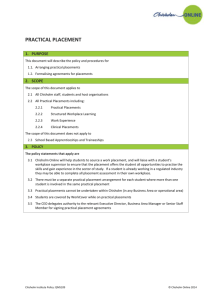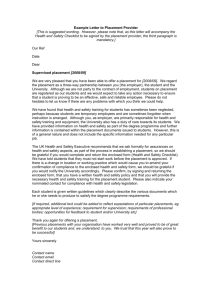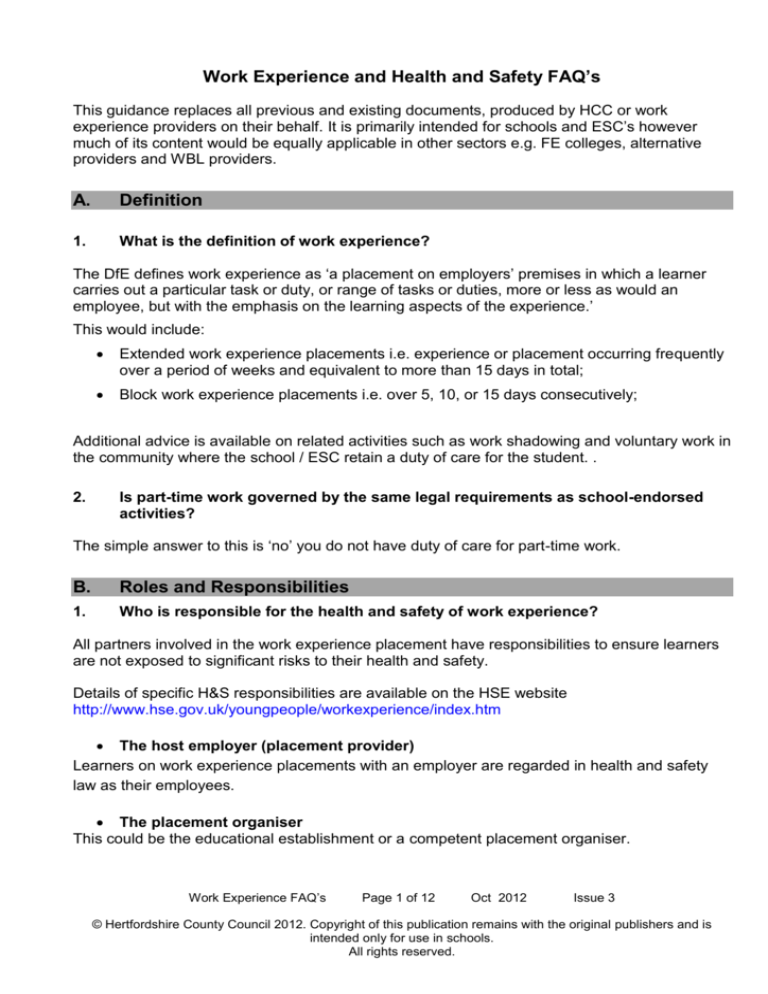
Work Experience and Health and Safety FAQ’s
This guidance replaces all previous and existing documents, produced by HCC or work
experience providers on their behalf. It is primarily intended for schools and ESC’s however
much of its content would be equally applicable in other sectors e.g. FE colleges, alternative
providers and WBL providers.
A.
Definition
1.
What is the definition of work experience?
The DfE defines work experience as ‘a placement on employers’ premises in which a learner
carries out a particular task or duty, or range of tasks or duties, more or less as would an
employee, but with the emphasis on the learning aspects of the experience.’
This would include:
Extended work experience placements i.e. experience or placement occurring frequently
over a period of weeks and equivalent to more than 15 days in total;
Block work experience placements i.e. over 5, 10, or 15 days consecutively;
Additional advice is available on related activities such as work shadowing and voluntary work in
the community where the school / ESC retain a duty of care for the student. .
2.
Is part-time work governed by the same legal requirements as school-endorsed
activities?
The simple answer to this is ‘no’ you do not have duty of care for part-time work.
B.
Roles and Responsibilities
1.
Who is responsible for the health and safety of work experience?
All partners involved in the work experience placement have responsibilities to ensure learners
are not exposed to significant risks to their health and safety.
Details of specific H&S responsibilities are available on the HSE website
http://www.hse.gov.uk/youngpeople/workexperience/index.htm
The host employer (placement provider)
Learners on work experience placements with an employer are regarded in health and safety
law as their employees.
The placement organiser
This could be the educational establishment or a competent placement organiser.
Work Experience FAQ’s
Page 1 of 12
Oct 2012
Issue 3
© Hertfordshire County Council 2012. Copyright of this publication remains with the original publishers and is
intended only for use in schools.
All rights reserved.
The school, college , ESC
The education establishment where the learner is on roll (and thus the head teacher) retains a
duty of care during the placement. They will also have additional responsibilities where they are
the employer or when acting as the placement organiser.
In HCC schools the LA is the employer for Community, Community special schools, Voluntary
controlled, special schools and ESCs and is thus ultimately responsible. However headteachers
have a duty to ensure that the County Council’s policy and procedures for work placements are
implemented.
For Foundation, Voluntary aided and Academy schools, the Governing body or trustees would
be regarded as the employer and thus responsible. The LA can provide a Health & Safety
advisory service for such schools which would include a number of hours for the school to use
as they require for proactive work. For further information see Prospectus for services to
schools.
What are the school’s responsibilities with regard to the policy for safe
implementation of work experience?
2.
Each education establishment should have:
A work experience policy (often integrated into the careers education/work-related
learning policy) that is part of the development plan and regularly reviewed and updated;
A committed senior manager who understands the legal and moral duties in relation to
work experience;
Governors who are committed to work experience and understand their liabilities;
Dedicated resources in terms of staff time and budget allocation;
Service level agreements with any placement organisers external to the school/college
who are providing placements.
3.
Are the requirements different for 14-16 and 16+?
Health and safety law defines all those under 18 as a young person and therefore at
potentially increased risk in a workplace environment due to their lack of experience
and maturity. Therefore the same protocols should be adopted for all learners as far
as Health and Safety is concerned.
For learners with learning difficulties and disabilities (LLDD) up to the age of 25
additional safeguards may be identified and thus placements should be considered
and risk assessed on an individual basis.
4.
What recommendations would the county want to see in preparing the young
people to be responsible for their health and safety whilst in the workplace?
Schools should brief students before taking part in work experience on:
supervision arrangements and health and safety responsibilities;
arrangements for placement visits;
arrangements for debriefing, assessment and recording.
Work Experience FAQ’s
Page 2 of 12
Oct 2012
Issue 3
These briefings should be recorded.
Schools must make suitable arrangements to visit/monitor students as the school retains a duty
of care for the student during the placement.
Schools must ensure that emergency contact arrangements are in place (including out of school
hours provision) in order that a member of school staff can be contacted should an incident
occur.
HCC is recommending all young people obtain a health and safety award. The Institution of
Occupational Safety and Health (IOSH) has developed a workplace hazards awareness course
(WHAC) for year 10 students. Wiseup2work is designed to help teenagers learn the health and
safety basics and to develop the right attitude to safety. The British Safety Council also offer
awards.
Log on to http://www.wiseup2work.co.uk/office.html to register your school for the new course.
The course leads to an entry level award in workplace hazard awareness (entry 3).
Schools may wish to use employability and personal development qualifications as a means of
accrediting preparation and work experience activity e.g. C&G 7546
C.
Organising the Placement
1.
Who can we use to undertake health and safety checks for us?
Pre-placement health and safety assessments of employers can be conducted by any provider
meeting the competency requirements outlined below. Schools must evaluate the effectiveness
of the providers arrangements ensuring they are utilising documented checks equivalent to
those outlined below.
Placements must not begin until confirmation has been received that the following have
been obtained from the provider:
2.
Evidence of relevant qualifications, continuous professional development and updating of
knowledge and occupational competency.
Copies of documentation used when assessing a placement.
Who is competent to assess a placement?
In order for the LA or Governing body to meet their legal duties toward learners placed on work
experience, the placement organiser must be able to evidence their competence, both in the
occupational areas and in health and safety.
Competent staff should as a minimum hold underpinning H&S knowledge. This may be
demonstrated by the possession of the following nationally accredited/recognised qualifications:
IOSH (The Institute of Occupational Safety and Health) Managing Safely qualification,
IOSH provide details of course providers by area on their website
Work Experience FAQ’s
Page 3 of 12
Oct 2012
Issue 3
IOSH Health and Safety for Work-placement Personnel course or HSS8 (Formerly ENTO
Unit D) Review Health and Safety Procedures in Workplaces – this is an optional unit
from NVQ level 3 in health and safety but is also a stand alone qualification for people
required to review health and safety conditions in workplaces other than their own.
Occupational competence, knowledge and understanding in relation to sector specific
placements should also be demonstrable. Particularly in high risk placements such as
construction, agriculture, equestrian etc.
In addition placement organisers may have obtained other national quality awards in recognition
of best practice in delivery of placements such as the CEI National Standard Award for Work
Experience organisers.
3.
What standards of health and safety should be expected?
The assessment of health and safety for learners should be undertaken using a
proportionate approach (depending on the level of risk, type of learning, and the kind
of learner) and placement providers should use an informed judgement on what is reasonable
for the kind of learning taking place.
To ensure learning takes place in a safe, healthy and supportive environment the “Health and
Safety Standards for Learners”, established by the SFA and agreed with the HSE and DfE
reflect the main legal requirements and are a recognised benchmark for assessing the suitability
of an organisations health and safety. These are also summarised at the end of this document.
4.
Can employers used for KS4 placements be used for Post-16 learners?
Never assume that a placement has a valid health and safety assessment without first checking
this out.
Health and safety visits are carried out on the basis of activities to be undertaken during the
placement which will be linked to the ability and maturity of the learners. Year 10 learners and
post-16 learners are unlikely to be undertaking the same level of activities. Post-16 learners
should be involved in higher level tasks.
D.
Timing of Work Experience
1.
What hours can learners work while on work experience?
The number of hours worked and the pattern of work is normally a matter for agreement by the
employer, school and students. Students on work experience placements should not be asked
to work excessively long hours or unnecessarily unsocial hours. Students should not work for
more than five days in any consecutive seven day period and it is strongly recommended that
students should not be asked to work more than a standard eight-hour day.
Work Experience FAQ’s
Page 4 of 12
Oct 2012
Issue 3
2.
Can I send students out on work experience during the school holidays e.g. during
the summer break?
At all times you need to ensure that you are taking all reasonable care to ensure the safety of
your students.
You therefore need to answer the following questions and only proceed with this arrangement if
the answer is ‘yes’ to each one.
Is there a dedicated emergency contact number with a person from the school at the end
of the phone for the duration of the placement if needed?
Is there someone from the school who knows the young person and is appropriate in
terms of monitoring the students’ progress available to visit them at the placement?
Does the school’s insurance policy cover young people during the holiday periods?
Has the parent or carer given consent to the young person undertaking the placement
during the holiday time and have they consented to the job description and seen the
young person’s risk assessment?
3.
Our Year 12 students undertake summer internships outside of term time, as
the internship takes place in the students own time to what extent do we have a
duty of care?
Where students are making completely private placements outside of term time then there is
no direct duty of care involved for the school, in reality it would be akin to them taking a part
time job for example and the primary duty lies with the employer. It's the employing service
who must comply with the 'normal' health and safety standards and ensure the student is
aware of all relevant H&S issues.
However if the school are directly involved in the placement process and organisation then
clearly there is more of a duty and the school could then be viewed as having responsibilities
to ensure pupil safety as part of that e.g. by conducting a check of the employer via a
competent person.
E.
Cross County and Abroad
1.
What are the implications for learners in Herts accessing placements in our
border counties?
There is a network of East of England Work Experience providers who continue to operate and
offer cross border arrangements regarding health and safety checks to facilitate the placement
of young people in neighbouring counties. This group have agreed standardised
documentation. Members of this group will liaise with their counterparts and arrange for the
checks to be done.
Out of county placements can go ahead on the approval of the headteacher provided that:
Pre-placement health and safety assessments of employers are carried out by competent
people (see section C);
Accommodation arrangements (where applicable) are suitable;
Work Experience FAQ’s
Page 5 of 12
Oct 2012
Issue 3
2.
The school undertakes detailed preparation with the student pre-placement and has
arrangements in place to monitor and supp ort the student.
Can I send young people abroad for their work experience?
If work experience is to take place outside of the UK, it would be advisable to restrict it to
students over the age of 16.
This type of arrangement may come under the terms and conditions of exchange visits.
Accommodation arrangements during the placement must be suitable and the placement
approved by the headteacher.
Schools wishing to offer placements abroad should contact the Offsite Visits Adviser or
Education H&S Team in the first instance for advice.
F.
Involvement of Parents
1.
What checks should be in place for private placements e.g. those found by a
parent?
A duty of care rests with the school to ensure the placement is appropriate, thus parental
placements still need to be subject to the same standard of pre-placement checks as with other
employers.
H&S checks must still be carried out by qualified and competent people and supporting
documentation completed.
2.
Why is it important to get parents’ consent for a specific placement to be
undertaken?
Every learner should receive a placement job description from their learning organisation
highlighting the tasks to be undertaken and the necessary health and safety information
(including the risk assessment for the placement). It will also cover hours of work, dress code
and provide contact details and the employers address, this should be passed onto parents for
signature as part of the process for gaining consent in order they have full knowledge of what
the young person will be doing and where. General consent forms do not replace this
requirement.
G.
Monitoring of Placements
1.
Why should learners’ be visited while they are on their placement?
Again, as part of fulfilling your duty of care, a school, ESC or college needs to demonstrate all
reasonable precautions have been taken to ensure that your learners are safe, being
appropriately supervised and undertaking tasks as outlined in the job description you have
given them. The only way to check this out is to see first-hand.
Work Experience FAQ’s
Page 6 of 12
Oct 2012
Issue 3
A phone call is better than nothing and the minimum requirement is that you ring both the young
person and the employer independently to check that both parties are happy and that they are
benefiting from the experience. The phone call should be during the initial days of the
placement.
H.
Travel to Work Experience
1.
Who is responsible for the travel arrangements?
Travel to work placements from home are the responsibility of the learner. Any journey which
starts from school (e.g. a group visit) is the responsibility of the school.
However explaining the need for safety when travelling to and from the placement and
highlighting relevant hazards should be an important part of the work experience preparation
briefing for the learner. Schools should assess whether each young person can travel safely
and would need to demonstrate such risks have been considered.
Employers are responsible for travel between locations if this is within the nature of the job. The
need for such travel and adequate insurance cover would form part of the health and safety
checks for the placement.
I.
Reporting Accidents
1.
What should you do in the event of an accident?
Where work experience students are on a school roll, accidents must be reported by the
employer to the school. As a school your first priority is the well being of the young person and
communicating with parents and carers who should be notified immediately if treatment is
required beyond a minor injury.
Schools must report all incidents involving students on work placement activities to the
placement organiser and their employer (Governing body or the LA) at the earliest possible
opportunity. Using the relevant form (IDOR)
2.
In the case of an accident who do the HSE approach?
The HSE (The Health and Safety Executive) will initially focus on the employer during any
investigation as they have the responsibility under RIDDOR to report accidents.
J.
Risk Assessment
1.
What is risk assessment?
A risk assessment is simply the identification of what in the work placement could cause harm to
the learner and ensuring appropriate control measures are in place to reduce these risks to as
low a level as possible (whilst retaining the value of the work experience for the learner).
2.
Who is responsible for risk assessment?
Each individual employer has the responsibility for conducting a risk assessment and ensuring
that risks to all learners must be assessed before they start work. For children of compulsory
Work Experience FAQ’s
Page 7 of 12
Oct 2012
Issue 3
school age parents/ carers must be informed of the key findings of this assessment and control
measures taken.
The risk assessment must take into account specific factors such as immaturity, inexperience
and lack of awareness, and medical conditions, physical and learning disabilities of the learner.
Any relevant information relating to an individual learner (health, learning or language difficulties
etc.) must be provided by the school to the placement organiser and employer in order for job
descriptions/risk assessments/supervision etc to be adjusted accordingly.
External organisations do not have a duty to say whether the employer’s risk assessment is
suitable or sufficient.
3.
What is the schools role in this risk assessment?
Schools need to ensure that placement organisers and employers are provided with all relevant
information about the learners, for example relating to health, learning or language difficulties or
other factors which might affect their ability to understand and respond to information and
instructions about health and safety at work.
4.
When would CRB checks be required ?
Details of HCC CRB requirements are held on
http://www.thegrid.org.uk/schoolworkforce/human_resources/crb/crb_who/index.shtml
In the vast majority of cases as there would be no regular unsupervised access there is no need
for a CRB check.
Additional safeguards and where applicable CRB checks must be considered on a case by case
basis and where one or more of the following conditions are met
Students identified as vulnerable (for educational, medical, home circumstances or
behavioural reasons);
Students on placement of > 15 days, particularly where these involve
o regular lone working with an employer (anything over half a day at a time)
o placements in isolated environments with 1;1 working
o placements with a high degree of travelling in a 1:1 basis
Placements with a residential element
Regardless of this, the employer should endorse a set of principles or have a CP policy.
K.
Students Attending FE Colleges
1.
What are the schools responsibilities for students attending FE colleges?
The school and college must establish clear arrangements for supervision and management of
students on college premises. Such arrangements are similar to those outlined above and
should cover areas such as:
Work Experience FAQ’s
Page 8 of 12
Oct 2012
Issue 3
Supervision and monitoring ( during teaching time and breaks / free periods)
Reporting attendance
Arrangements for students with disabilities or specific medical requirements
Safeguarding
Travel between school and college
Name and contact details of school / college representatives
Parental consent
Sharing relevant risk assessments with students and parents/guardians
Arrangements for any visits, work placements or other off site activities forming part of
the programme
Where work placements form part of the vocational qualification offered by a FE college then
the college is responsible for ensuring placement checks are conducted, these should be to
the same standards and conducted by suitably qualified and competent people as set out in
section C.
Further Information
Who to contact for help and advice:
James Ottery,
Health and Safety Manager
Email james.ottery@hertfordshire.gov.uk.
Mary Hurlstone
14 – 19 Progression Manager, Strategy and Commissioning
Email mary.hurlstone.hertfordshire.gov.uk
HSE Young People at work
http://www.hse.gov.uk/youngpeople/index.htm
http://www.hse.gov.uk/services/education/faqs.htm#a1
DfE advice on health & safety
Work related Learning guide – Second Edition
https://www.education.gov.uk/publications/eOrderingDownload/work-related.pdf
Work experience a guide for secondary schools
https://www.education.gov.uk/publications/eOrderingDownload/SPDWES0102REV.pdf
A guide to the law for Governors
http://education.gov.uk/b0065507/gttl/health-safety-welfare
14-19 Safeguarding and WRL legal updates from Tony Johns
This free monthly newsletter collates information from various sources relevant to Work-related learning
and associated protection of children and young persons. Anyone working in this area who would like to
be added to the circulation list can forward their details to – tonyjohns@enterprise.net
Work Experience FAQ’s
Page 9 of 12
Oct 2012
Issue 3
Glossary
CEI
Centre for Education and Industry
ENTO
ENTO is the learning network for assessors and verifiers. It is responsible for
developing the national occupational health and safety competency standards
(www.ento.co.uk).
HSE
The Health and Safety Executive is a government agency responsible for the
regulation of almost all the risks to health and safety arising from work activity in
Britain. Its job is to help ensure that risks to people's health and safety from work
activities are properly controlled (www.hse.gov.uk)
IOSH
The Institute of Occupational Safety and Health is an independent, not-for-profit
organisation. Its members are people with a professional involvement or interest in
occupational health and safety (www.iosh.co.uk).
RIDDOR
Reporting of incidents, diseases and dangerous occurrences regulations 1995
Work Experience FAQ’s
Page 10 of 12
Oct 2012
Issue 3
Employer / Location Health, Safety and Welfare Assessment Standards
1. Health and Safety Policy
a) Demonstrable commitment to health and safety (and a written policy statement where there are
five or more employees).
b) Responsibilities for health and safety are clearly stated (and recorded where there are five or
more employees).
c) Arrangements for health and safety are clearly stated
d) The commitment, responsibilities and arrangements for health and safety are communicated to
all employees and their understanding/awareness checked.
2. Risk Assessment
a) Risk assessments have been carried out, covering employees and young persons and significant
risks identified.
b) Significant risks have been recorded
c) Suitable control measures have been identified and implemented as a result of risk assessment.
d) The significant risks and control measures are explained to employees (and others as
appropriate).
e) Risk assessments are reviewed and active monitoring takes place and the findings acted upon.
3. Accidents, including the provision of first aid
a) Adequate arrangements for first aid materials have been made.
b) Adequate arrangements for trained first aiders have been made.
c) All accidents and first aid treatment recorded.
d) Arrangements exist for reporting of near misses / safety concerns to management
e) Accidents, incidents and ill-health are or will be reported to the enforcing authority as appropriate
and investigated.
f) Accident and first aid arrangements are made known to all employees and others as appropriate.
4. Supervision, training, information and instruction
a) Employees are provided with adequate competent supervision.
b) Appropriate health and safety information, training and instruction are given to all new employees
on recruitment.
c) Ongoing health and safety information, training and instruction are provided to all employees and
others as appropriate.
d) Information, instruction and training are recorded.
e) The effectiveness of training and competence in the workplace are both assessed and
assessments recorded.
5. Work equipment and machinery
a) The employer provides the correct equipment to the appropriate standard.
b) Equipment is adequately maintained.
c) Guards and control measures are in place as determined from risk assessment.
d) Safe electrical systems and equipment are provided and maintained.
6. Personal protective equipment and clothing (PPE)
a) Personal protective equipment and clothing is provided for employees as determined from risk
assessment.
b) Training and information on PPE use has been provided to employees.
c) The proper use of PPE is enforced.
d) PPE/C is maintained, replaced and where appropriate inspected.
Work Experience FAQ’s
Page 11 of 12
Oct 2012
Issue 3
7. Fire and emergencies
a) A means of raising the alarm and fire or emergency detection is in place.
b) Appropriate means of fire fighting are in place.
c) Effective means of escape are in place, including escape routes and unobstructed exits.
d) There is a named person (or persons) for emergencies.
e) Arrangements are maintained, which include tests and drills.
f) A fire log book is kept.
8. Safe and healthy working environment
a) Premises (structure, fabric, fixtures and fittings) are safe and healthy (suitable, maintained and
kept clean).
b) The working environment (temperature, lighting, space, ventilation, noise) is appropriate, safe
and healthy.
c) Welfare facilities (toilets, washing, drinking, eating, changing) are provided as appropriate and
maintained.
d) Exposure to hazards from physical, chemical and biological agents is adequately controlled.
9. Health and safety management
a) The employer consults and communicates with employees on health and safety and allows them
to participate in health and safety.
b) The employer provides medical or health screening as appropriate and any required medical
surveillance
c) The employer has access to competent advice
d) The employer reviews health and safety regularly, ideally on an annual basis.
e) The employer provides and displays necessary signs or notices.
f) Employers’ liability insurance is current and other insurance is in place, as appropriate to the
business undertaking. This includes informing insurers and/or brokers where appropriate of the
learner(s)’ presence and programmes.
g) The employer assesses, reviews and updates employees’ capabilities.
h) The employer manages the employee’s work when it is away from the employer’s own premises
or when the employee is placed with another employer or site.
10. Learners and young person’s health, safety and welfare
a) The employer has assessed the risks to any learner and or young person taking account of his or
her age (and inexperience, immaturity and lack of awareness of risk) and any other special needs
or circumstances including any disability and/or medical condition.
b) The employer has put in place control measures for learners and/or young persons as a result of
10a and informed the learner and his or her supervisor.
c) The employer has identified any necessary prohibitions and restrictions that apply to any learner
and/or young person as part of items 10a and 10b above.
d) The employer provides competent supervision for any learner and young person and has a
designated person to take overall responsibility for any learner or young person.
e) The employer provides an induction and ongoing information, instruction and training to any
learner or young person, reflecting the result of the risk assessment; environment, tasks and the
learner or young person’s age, experience and any special needs.
f) The employer provides free of charge any necessary (determined from the risk assessment)
personal protective equipment and clothing to the learner and ensures its proper and effective
use.
Work Experience FAQ’s
Page 12 of 12
Oct 2012
Issue 3


